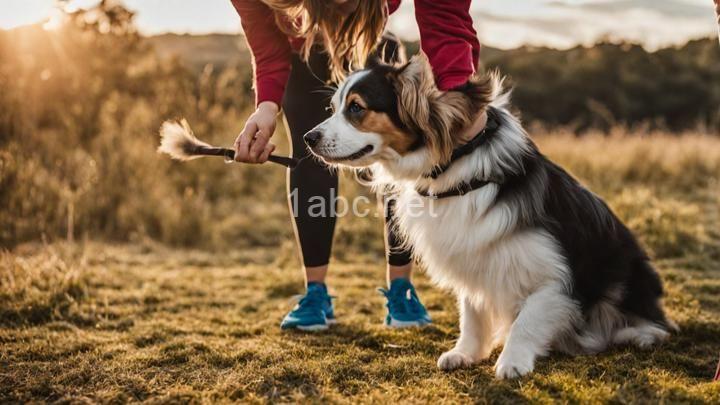How to Develop a Tailored Exercise Routine for Your Family Pet

Introduction:
Welcome to our guide on creating a customized exercise routine for your beloved family pet! As pet owners, we all want our furry friends to live long, healthy, and happy lives. Regular exercise is a crucial component of their overall well-being, just like it is for us humans. In this blog post, we'll explore the importance of exercise for pets, help you assess your pet's needs, choose suitable exercises, create a schedule, make it fun, and monitor their progress. So let's dive in and get those tails wagging!
Assessing Your Pet's Needs:
Understanding your pet's breed, age, size, and any special considerations is essential when determining their exercise requirements. Different breeds have different energy levels and predispositions to certain health issues. For example, a Border Collie will need more exercise than a Pug. Take some time to research your pet's breed characteristics and consult with your veterinarian for personalized advice. Additionally, consider any medical conditions or restrictions your pet may have. This information will help you tailor their exercise routine to meet their specific needs, ensuring their safety and well-being.
To help you assess your pet's exercise requirements, here's a checklist of questions to consider:
- What breed is your pet, and what are their typical energy levels?
- How old is your pet? Puppies and younger animals generally have higher activity needs.
- Does your pet have any health conditions or restrictions that may affect their exercise routine?
- What is the size of your pet? Smaller pets may not require as much exercise as larger ones.
- Does your pet have any behavioral issues that may be alleviated through exercise?
Choosing Suitable Exercises:
Now that you have a better understanding of your pet's needs, it's time to choose suitable exercises. Dogs, for example, benefit from activities like walking, running, swimming, playing fetch, and engaging in agility training. Cats, on the other hand, may enjoy interactive toys or climbing structures. Consider your pet's energy levels, preferences, and any limitations imposed by their breed or health conditions. It's important to select exercises that will keep them engaged, challenged, and happy.
When engaging in physical activities with your pet, keep their safety in mind. Depending on the exercise, you may need equipment such as leashes, harnesses, life jackets for swimming, or protective gear for agility training. Always supervise your pet and ensure that the environment is safe and conducive to exercise.
Creating a Schedule:
Consistency is key when it comes to establishing an exercise routine for your pet. Regular exercise helps maintain their physical health, as well as their mental well-being. Based on your pet's age, breed, and physical condition, determine an appropriate duration and frequency for their exercise sessions. Puppies, for instance, may need shorter bursts of exercise with more frequent breaks, while adult dogs may benefit from longer walks or play sessions. Consider incorporating exercise into your daily routines without disrupting other family activities. For example, you could take your dog for a walk before breakfast or play fetch in the backyard after dinner.
Making it Fun:
Exercise doesn't have to be a chore; it can be a fun and bonding experience for both you and your pet. Incorporate playtime and interactive toys into their exercise routine. Cats may enjoy chasing laser pointers or playing with feather wands, while dogs might love chasing bubbles or playing tug-of-war. Adding variety to their exercise routine keeps them engaged and excited. Explore different parks, trails, or beaches in your area to provide new and stimulating environments for your pet. Additionally, involving other family members in exercising with your furry friend can strengthen the bond between them and create memorable experiences.
Monitoring Progress:
Monitoring your pet's progress is essential to ensure they are getting adequate exercise without overexertion. Tracking their activity levels using wearable devices specifically designed for pets can give you valuable insight into their daily exercise habits. Alternatively, you can create a journal and record their activities, including the type of exercise, duration, and any noticeable changes in behavior or energy levels. By monitoring their progress, you can make adjustments as needed to optimize their exercise routine and address any concerns that may arise.
Conclusion:
Developing a tailored exercise routine for your family pet is an investment in their overall health and happiness. Regular exercise not only helps maintain their physical well-being but also stimulates their minds and strengthens the bond between you and your furry friend. Remember to assess your pet's needs, choose suitable exercises, create a consistent schedule, make it fun, and monitor their progress. Every pet is unique, so feel free to adapt these guidelines to suit your furry friend's specific needs. Now, it's time to get out there and enjoy some quality exercise time with your pet. Happy exercising!
FREQUENTLY ASKED QUESTIONS
Why is it important to have a tailored exercise routine for my family pet?
Having a tailored exercise routine for your family pet is important for several reasons. Firstly, just like humans, pets need regular exercise to maintain a healthy weight and overall well-being. Without enough physical activity, pets can become overweight or obese, which can lead to various health issues such as diabetes, joint problems, and heart disease. By having a tailored exercise routine, you can ensure that your pet gets the right amount of activity to keep them fit and healthy.
Secondly, exercise is not only beneficial for your pet's physical health but also for their mental stimulation. Regular exercise helps to reduce boredom and prevent behavioral problems such as excessive barking, chewing, or digging. It provides an outlet for their energy and helps to keep them mentally engaged and happy.
Additionally, a tailored exercise routine allows you to cater to your pet's specific needs and abilities. Different pets have different exercise requirements based on their breed, age, and overall health condition. For example, small breeds may require shorter bouts of exercise compared to larger breeds. Older pets may need low-impact activities to avoid putting strain on their joints. By tailoring the exercise routine to your pet, you can ensure that they are getting the appropriate level of exercise without causing any harm or discomfort.
Lastly, having a tailored exercise routine for your family pet can also strengthen the bond between you and your pet. Engaging in activities together, such as going for walks or playing fetch, allows you to spend quality time with your pet and build a deeper connection. It creates opportunities for positive reinforcement and training, which can further enhance your pet's behavior and obedience.
In conclusion, having a tailored exercise routine for your family pet is important for their physical health, mental stimulation, and overall well-being. It ensures that they receive the right amount and type of exercise to keep them healthy, happy, and bonded with their human family members.
How do I determine the right amount of exercise for my pet?
Determining the right amount of exercise for your pet can vary depending on factors such as their age, breed, and overall health. It's important to strike a balance between keeping them active and avoiding overexertion. Here are a few steps to help you determine the right amount of exercise for your furry friend:
-
Consult with your veterinarian: Start by consulting with your veterinarian to get a professional opinion on your pet's exercise needs. They will consider your pet's age, breed, weight, and any underlying health conditions that may affect their exercise capacity.
-
Consider your pet's breed characteristics: Different breeds have different exercise requirements. For example, high-energy breeds like Border Collies may need more intense exercise sessions compared to smaller, low-energy breeds. Understanding your pet's breed characteristics can give you a general idea of their exercise needs.
-
Observe your pet's behavior: Pay attention to your pet's behavior during and after exercise. If they seem excessively tired, panting heavily, or struggling to catch their breath, it may be a sign that they are being overexerted. On the other hand, if they have excess energy and seem restless, they may need more exercise.
-
Gradually increase exercise intensity: Start with moderate exercise sessions and gradually increase the intensity and duration over time. This allows your pet to build stamina and prevent injuries. Keep in mind that puppies and senior pets may have different exercise requirements than adult pets.
-
Consider mental stimulation: Exercise doesn't have to be limited to physical activities alone. Mental stimulation, such as puzzle toys or training sessions, can also help keep your pet engaged and active.
Remember, each pet is unique, and it's important to tailor their exercise routine to their individual needs. Always listen to your pet's cues and consult with a veterinarian if you have any concerns about their exercise regimen. Happy exercising!
What types of exercises are suitable for different pets?
When it comes to exercise, different pets have different needs and abilities. Here are some types of exercises that are suitable for different pets:
-
Dogs: Dogs are active animals that require regular physical exercise. Walking, jogging, and hiking are great exercises for dogs. Playing fetch, tug-of-war, and agility training are also fun ways to keep them active and mentally stimulated.
-
Cats: Cats are known for their agility and love for play. Interactive toys, such as feather wands and laser pointers, can provide mental and physical stimulation. Cat trees and scratching posts are great for climbing and stretching. Encouraging them to chase toys or play hide-and-seek can also keep them entertained.
-
Birds: Birds need exercise to maintain their physical health and prevent boredom. Flying is a natural exercise for birds, so providing them with enough space to fly freely is important. You can also provide perches and toys that encourage climbing, swinging, and hopping.
-
Small mammals (e.g., rabbits, guinea pigs): These animals can benefit from activities that simulate their natural behavior. Providing them with tunnels, chew toys, and puzzle feeders can keep them physically active and mentally stimulated. Creating an obstacle course or setting up a playpen can also provide them with opportunities for exercise.
-
Fish: Unlike other pets, fish don't require physical exercise in the same way. However, providing them with a spacious and well-maintained aquarium with plenty of swimming space and hiding spots is important for their overall well-being.
Remember, it's important to consider your pet's age, health condition, and breed characteristics when choosing suitable exercises. Consulting with your veterinarian can help you determine the best exercise routine for your furry or feathered friend.
How often should I exercise my pet?
When it comes to exercise for your pet, the frequency depends on a few factors such as the type of pet, their age, and their overall health. Generally, dogs should be exercised at least once a day, while cats may require less structured exercise. However, it's important to note that each pet is unique, so it's best to consult with your veterinarian for personalized advice.For dogs, a daily walk or playtime in the backyard can help them burn off excess energy and keep them mentally stimulated. High-energy breeds may benefit from more vigorous exercise, such as running or playing fetch. On the other hand, older dogs or those with health issues may require gentler exercise, such as shorter walks or low-impact activities like swimming.
Cats, being more independent, often engage in play and exercise on their own. Providing them with toys, scratching posts, and vertical spaces to climb can help keep them active and entertained. Interactive play sessions with toys like feather wands or laser pointers can also be a great way to engage cats in exercise.
Remember, the goal is to strike a balance between keeping your pet physically active and preventing them from becoming overexerted or bored. It's important to pay attention to their cues and adjust the exercise routine accordingly. Regular exercise not only helps maintain a healthy weight but also promotes good mental and emotional well-being for your furry friend.

